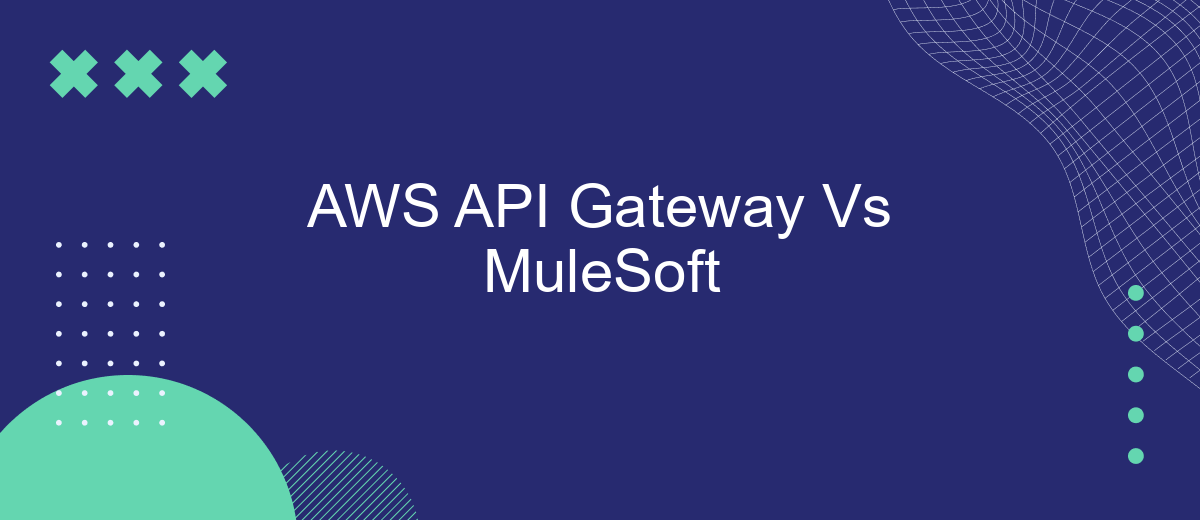In the rapidly evolving landscape of cloud computing and integration platforms, choosing the right API management solution is crucial for businesses. AWS API Gateway and MuleSoft are two prominent contenders, each offering unique features and capabilities. This article delves into a comparative analysis of AWS API Gateway and MuleSoft, helping you determine which platform best suits your organizational needs.
Introduction
In today's rapidly evolving digital landscape, businesses are increasingly reliant on robust API management solutions to streamline their operations and enhance connectivity. Two prominent players in this space are AWS API Gateway and MuleSoft, each offering unique features and capabilities tailored to different use cases.
- AWS API Gateway: A fully managed service that makes it easy for developers to create, publish, maintain, monitor, and secure APIs at any scale.
- MuleSoft: A comprehensive integration platform that enables businesses to connect applications, data, and devices with APIs and integrations.
Choosing the right API management solution is crucial for ensuring seamless integration and maximizing efficiency. While AWS API Gateway excels in scalability and ease of use, MuleSoft offers extensive integration capabilities and flexibility. Additionally, tools like SaveMyLeads can further simplify the process by automating lead management and other workflows, making it easier for businesses to focus on growth and innovation.
Architecture and Components

AWS API Gateway is a fully managed service that allows developers to create, publish, maintain, monitor, and secure APIs at any scale. It acts as a "front door" for applications to access data, business logic, or functionality from backend services. The architecture of AWS API Gateway includes components such as RESTful APIs, WebSocket APIs, and integration with AWS Lambda for serverless computing. The service also supports monitoring and logging through AWS CloudWatch, and offers security features like AWS Identity and Access Management (IAM) and Amazon Cognito for authentication and authorization.
MuleSoft, on the other hand, provides a comprehensive integration platform called Anypoint Platform, which includes tools for designing, building, and managing APIs and integrations. The architecture of MuleSoft's Anypoint Platform consists of various components such as Anypoint Studio for API design, Anypoint Exchange for sharing APIs and templates, and Anypoint Management Center for monitoring and governance. MuleSoft also supports a wide range of connectors for integrating with different systems and services, making it easier to set up complex integrations. For businesses looking to automate and streamline their integration processes, services like SaveMyLeads can further enhance the capabilities of MuleSoft by providing pre-built connectors and automation tools.
Features and Capabilities

When comparing AWS API Gateway and MuleSoft, it's essential to examine their features and capabilities to determine which platform best suits your integration needs. Both platforms offer robust tools for API management, but they cater to different requirements and use cases.
- API Management: AWS API Gateway provides a fully managed service for creating, publishing, maintaining, monitoring, and securing APIs. MuleSoft's Anypoint Platform offers a comprehensive suite for API design, implementation, and management.
- Integration Capabilities: MuleSoft excels in connecting various applications, data sources, and devices, making it a go-to solution for complex integration scenarios. AWS API Gateway, while powerful, is more focused on API lifecycle management within the AWS ecosystem.
- Customization and Flexibility: MuleSoft offers extensive customization options and pre-built connectors for various third-party services, including SaveMyLeads, which simplifies the integration process. AWS API Gateway also allows for customization but is more tightly integrated with other AWS services.
Ultimately, the choice between AWS API Gateway and MuleSoft depends on your specific needs. If you require extensive integration capabilities and flexibility, MuleSoft may be the better option. However, for a seamless experience within the AWS ecosystem, AWS API Gateway is a strong contender.
Use Cases and Industry Applications

When evaluating AWS API Gateway and MuleSoft, understanding their use cases and industry applications is crucial. AWS API Gateway is often preferred for serverless architectures and microservices, making it ideal for startups and tech companies focusing on scalability and cost-efficiency. On the other hand, MuleSoft excels in complex enterprise integrations, particularly for organizations with a diverse set of legacy systems.
Both platforms offer unique advantages tailored to specific industry requirements. AWS API Gateway is commonly used in e-commerce for handling high-volume API requests, while MuleSoft is favored in the financial and healthcare sectors for its robust data transformation and orchestration capabilities.
- Startups and tech firms: AWS API Gateway for scalable, cost-effective API management.
- Enterprises with legacy systems: MuleSoft for comprehensive integration solutions.
- E-commerce: AWS API Gateway for managing high-volume transactions.
- Financial and healthcare sectors: MuleSoft for secure and reliable data integration.
For businesses looking to streamline their integration processes, tools like SaveMyLeads can further enhance the capabilities of both AWS API Gateway and MuleSoft. SaveMyLeads simplifies the automation of lead data transfer, making it an invaluable asset for marketing and sales teams.
Pricing and Support
When it comes to pricing, AWS API Gateway offers a pay-as-you-go model, which can be cost-effective for businesses with variable usage patterns. The pricing is based on the number of API calls, data transfer, and additional features like caching. AWS also provides a free tier that includes 1 million API calls per month for the first 12 months, making it an attractive option for startups and small businesses. On the other hand, MuleSoft operates on a subscription-based pricing model, which can be more predictable for enterprises with consistent usage. The subscription includes access to the Anypoint Platform, which offers a comprehensive suite of integration tools.
In terms of support, AWS offers multiple support plans ranging from basic free support to premium plans with 24/7 access to technical support, a dedicated account manager, and faster response times. MuleSoft also provides robust support options, including a customer success program, training resources, and 24/7 support for its enterprise customers. For businesses looking to streamline their integration processes, services like SaveMyLeads can be invaluable. SaveMyLeads automates lead data transfer between various platforms, reducing the need for manual intervention and ensuring seamless integration.


FAQ
What are the primary differences between AWS API Gateway and MuleSoft?
Can AWS API Gateway and MuleSoft be used together?
Which service is better for a small business with limited technical resources?
How do both services handle security?
Are there tools to automate integrations when using AWS API Gateway or MuleSoft?
What do you do with the data you get from Facebook lead forms? Do you send them to the manager, add them to mailing services, transfer them to the CRM system, use them to implement feedback? Automate all of these processes with the SaveMyLeads online connector. Create integrations so that new Facebook leads are automatically transferred to instant messengers, mailing services, task managers and other tools. Save yourself and your company's employees from routine work.
